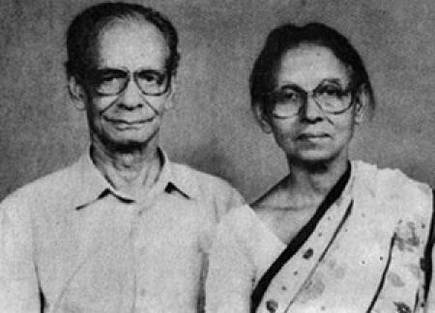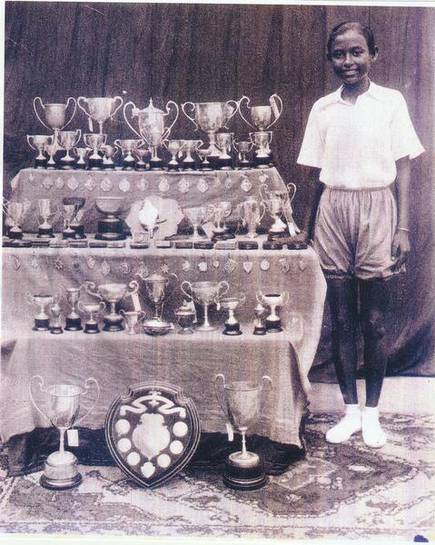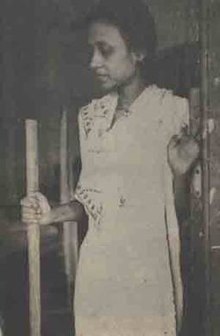Ila Mitra: the athlete, the litterateur, the peasant leader. A brilliant young lady who fronted a communist movement with her husband and his friends in the Rajshahi district of Bangladesh.
How did she come to be the Ila Mitra that history remembers?
Here’s how.
Ila was born on 18th October 1925 at Bagutia village in the Jessore district and was the eldest among her six siblings. Her father, Nagendranath Sen, was an Accountant General in Bengal.She completed her schooling at Bethune School in Bengal in 1940. Ila’s father encouraged her to participate in track competitions and accompanied her to her swimming practices. Ila was a gifted athlete who could have been the first Bengali woman to represent British India at the Olympics in 1940. However, at the onset of World War II, the Olympics did not take place that year.

Meanwhile, Ila joined the All-India Communist Partyin 1941. She was a member of the Calcutta Mohila Atmarakha Samiti. In 1942, she cleared her Intermediate exams, after which, in 1944, she graduated with a BA (Honours) from Bethune College in Bengal. Later on, after 14 years, she decided to attend Calcutta University to complete her M.A in Bengali Literature.
One may question why she decided to return to university after so many years. What did she do during these 14 years?
Well, it all started in 1945. Ila Sen was married to Ramendra Nath Mitra, who was the son of a Zamindar family of Ramchandrapur and took on his surname. Ramendra Nath Mitra, unlike other zamindars, was different as he understood the plight of the peasants and under his selfless leadership, he organised a communist movement in Maldah. Ila supported her husband in the movement, and her earlier ties with the Communist Party of India (CPI) helped her organise a peasant movement in the Nachole region of Nawabganj under the directive of the CPI.
In 1948, the couple had a son, but their active participation in the movement for the rights of the peasant left him under the care of Ramendra’s mother, Vishwa Mitra. The same year, Ila’s role in the movement became far more prominent and under her leadership, the “Tebhaga Andolan” rose.
Now, what is the Tebhaga Andolan?
The word Tebhaga means three portions in Bengali. The purpose of the Andolan was that the peasants who cultivated the land should have got a two-third share of the yield and the remaining should have been divided amongst the owners. However, the Zamindars who are on the top of the land distribution system leased the land through a permanent settlement under British law and only paid a fixed tax yearly depending on the quality and area of land owned by them and the remaining income generated through cultivation would be left for Zamindars to enjoy. The jotdars class is second in line in the distribution system. They worked on the land and would get a two-third share of the yield. The rest went to the cultivator. Other districts in North Bengal, on the other hand, offered the cultivator half of the yield.
This discrimination in pay was addressed by Ila as she met many cultivators and small farmers in the discrete corners of the village, hiding away from the police. Ila who was the messiah to these peasants now had earned herself a new name – ‘Rani Ma’.
In 1950, the movement became violent before all the landowners in and around Nachol agreed to the Sat Ari & Tebhaga Doctrine. The process was simple and effective. Once the crops were harvested, the leaders of the movement along with the landowner and cultivator were invited, then the crop was divided into three parts where the cultivator kept the two-third and the remaining belonged to the owner. However, the movement was considered as illegal looting of yield by the administrator and landowners. Collectively, the zamindar, jotdar, and landowners appealed to the administrators to put an end to this, which marked the beginning of the abuse and unrest of the innocent peasants as the police tortured and jailed the villagers who participated in the movement.

The reign of terror
About 2000 soldiers had arrived in Nachol and blazed 12 villages, killing many people as they moved towards the Chandipur village. The army, along with the police, was in search of the wanted leaders. This was an off-balance fight as it was thousands of Santal, Hindu and Muslim peasants on one side of the defence force fighting against the army and police who had modern firearms. Unfortunately, the defence force fell and hundreds of Santal members were killed while some managed to flee the country to save themselves from the inhuman treatment by the army and the police.
Ila refused to escape Nachol until all of her comrades were also safe. She was the real Rani Ma, as her comrades called her. The police and army had left no stones unturned until they arrested Ila and her comrades. The police tortured several of her comrades to make them confess that Ila Mitra was the leader of the fight that killed a number of policemen in the movement, but no one confessed. 50 peasants died in jail due to torture.
While the police couldn’t break any of her comrades, they turned to Ila. What they did to her was unimaginable and horrifying. She paid the price for being Hindu, a Communist and a relentless leader of the Tebhaga movement.
The government used its state machinery to coerce the citizens to confess, but Ila did not budge. In November 1950, a court case was opened for the killing of the ASI of Nachol and Ila was charged directly for murdering sepoys and an ASI. Manoroma Masima, a political leader and women’s rights activist, urged that she would give a vivid statement of what had happened in the Nachole police station. Along with Manorama, Bhanu Devi was one of the security prisoners, and a comrade had encouraged Ila to tell the truth.
Here is the excerpt from that statement: “No food was given to me, not even a drop of water. The same day in the evening the sepoys began to beat me on the head with the butt of their guns, in the presence of the S.I. I was profusely bleeding through the nose. Afterwards…Inside the cell again the S.I. ordered the sepoys to bring four hot eggs, and said, now she will talk. Thereafter four or five sepoys forced me to lie down on my back, and one pushed a hot egg through my private parts. I felt like I was being burnt with fire, and became unconscious. When I came back to my senses in the morning of the 9th, the S.I. and some sepoys came into my cell and began to kick me on the belly with their boots on. Thereafter a nail was pierced through my right heel. I was then lying half-conscious, and heard the S.I. muttering: “We are coming again at night, and if you do not confess, one by one the sepoys will ravish you”. At the dead of night, the S.I. and his sepoys came back and the threat was repeated. But as I still refused to say anything, three or four men got hold of me, and a sepoy began to rape me. Shortly afterwards I became unconscious. The next day on 10-1-50, when I became conscious again, I found that I was profusely bleeding and my cloth was drenched in blood. I was in that state taken to Nawabganj from Nachole. The sepoys in Nawabganj jail gate received me with smart blows.”

However, Ila and all the other accused were sentenced to life imprisonment on the charges that she was the leader who prompted the peasants against the Zamindars, jotdars, and landowners, and organised the Tebhaga movement and looted yields.
Ila’s medical condition worsened in prison; maybe her illness had been caused and/or worsened by the ill-treatment and torture she underwent in police custody. At Rajshahi central jail, in her weak mental and physical state, she still managed to think of her son’s birth and the following sixteen days of her life. She would worry about her husband, who was then still in hiding as a warrant of arrest was issued in his name. As days went by, her condition deteriorated and she was brought back to Dhaka Central Jail and then moved to Dhaka Medical College in 1953. Many students, gentry, and political leaders visited her when she was in DMC hospital. Moulana Bhasani and other leaders of the East Bengal Legislative Assembly articulated their concerns and stated they would release her.
In June of 1954, Ila was released on parole and was allowed to travel to Calcutta for medical treatment. Her recovery began and, in a few years, she joined the party activities and completed herM. A in Bangla from the University of Calcutta in 1957. Later, she joined Calcutta City College as a professor of Bangla. Her husband, who managed to escape from Nachol, had joined her and was a full-timer in CPI politics. Ila steadily became involved in West Bengal politics and was elected to the West Bengal Assembly four times (i.e., from 1967 to 1978).
The Central government of Pakistan repeatedly asked the Indian government to send Ila back to Pakistan as they came to know that she had recovered from her illness. As she was still a convict in a murder case, Ila was guarded by her well-wishers, as they knew her fate if she returned under that administration.
Ila could never return to East Pakistan, but she never forgot East Bengal. During the Liberation War in 1971, her house and party provided an open shelter for many in need.
She is remembered as the true daughter of Bangladesh for the sacrifices she made for the oppressed peasants and common masses and will truly be remembered in sharing the hardships of the people of Bangladesh.
Sadly, Ila Mitra passed away on 13th October 2002.
This year marks Ila’s 96th birth anniversary.
Written by-Vibhashi Nagda
Edited by- Riya Khetan
